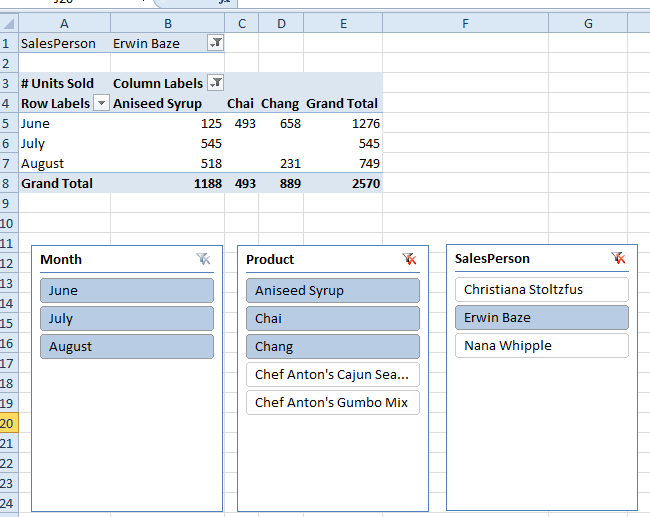

Since the chart is directly connected to the changing numbers, the range it becomes dynamic in nature. SLICERS can control both of them at a time. Both PIVOT FIELD & PIVOT CHARTS are interdependent. So I will advise you to use Excel Tables for auto-updating of the pivot ranges. If the data is increasing, you need to change the range of the pivot table every time data increases. Things to Remember about Excel Pivot Chart It shows drops, highs, lows, everything in a single graph. Visualization and numbers are interdependent. As per the selection you make in the slicer, both table and chart will show their results accordingly. Step 5: Now, you can control both table and chart from the SLICERS itself. Step 4: After selecting the option, you will see the actual slicer visual in your worksheet. Select for which field you need a slicer. Step 3: It will show you the options dialogue box. Step 2: Go to Option and select Insert Slicer. Step 1: Place a cursor inside the pivot table. In our previous section, we selected the month from the drop-down list either on pivot chart or on pivot field, but using SLICERS, we can visually. Slicers are visual filters to filter out any particular category for us. Insert a Slicer to the TableĪll these while you worked with filters in excel. Both are an interdependent option in excel. If any changes made to any file, it will affect both of them simultaneously. Your browser can’t show this frame.Note: Both PIVOT TABLE and PIVOT CHARTS are interdependent. It also shows the steps for this technique, if there are two or more columns with labels. To see the steps for using a multiple consolidation ranges pivot table, to rearrange your pivot table source data, watch this Excel video tutorial. The file is in xlsx format, and is zipped. Excel pivot table tutorial 2011 download#
Go to the Fix Pivot Source Data page, and look in the Download section. To test the multiple consolidation ranges technique, you can download the sample workbook from my Contextures website. With the amounts in a single columns, it’s easy to create totals, and use other summary functions, such as Average. Now that the source data is normalized, in a 3-column table instead of 13 columns, you can insert your final pivot table, based on the rearranged data.
Then, rename the heading cells as Product, Month, and Amount. Double-click the Grand Total cell, (cell A4 in the screen shot above), to create a new sheet, with the pivot table’s data in 3 columns. In the PivotTable Field List, remove the check marks from the Row and Column fields, so only the Grand Total for Value is left. A new sheet is added to the workbook, with a pivot table. Leave the other settings at their defaults, and click Finish. In Step 2b, click in the Range box, and on the worksheet, select the entire table, including the headings, and then click Add.  In Step 2a, select I Will Create The Page Fields, and then click Next. In Step 1, select Multiple Consolidation Ranges, and then click Next. Select a cell in the 13-column table, and press Alt+D, and then press P, to open the PivotTable and PivotChart Wizard. Follow these steps, to quickly fix Pivot Table source data: Instead of manually rearranging the data, or writing a macro, you can use a pivot table trick to change the 13-column data into a normalized 3-column table. With this 3-column Excel table, you can easily create a flexible pivot table, and focus of specific items or months. You could manually fix Pivot Table source data, or write an Excel macro to do the job for you, so it looks like the table shown below. In the adjacent columns, you can enter the product name and month name for each amount.
In Step 2a, select I Will Create The Page Fields, and then click Next. In Step 1, select Multiple Consolidation Ranges, and then click Next. Select a cell in the 13-column table, and press Alt+D, and then press P, to open the PivotTable and PivotChart Wizard. Follow these steps, to quickly fix Pivot Table source data: Instead of manually rearranging the data, or writing a macro, you can use a pivot table trick to change the 13-column data into a normalized 3-column table. With this 3-column Excel table, you can easily create a flexible pivot table, and focus of specific items or months. You could manually fix Pivot Table source data, or write an Excel macro to do the job for you, so it looks like the table shown below. In the adjacent columns, you can enter the product name and month name for each amount. 
Instead of a separate column for each month, the pivot table source data should have a single column for the sales amounts. When you create a pivot table, there are 12 value fields – one for each month – and you would have to create a calculated field to see an annual total. It has a column for each month, and the sales amounts are spread over those 12 columns. Sometimes you get data that isn’t well suited for creating a pivot table, like the example shown below. Get it right, and you won’t have to fix Pivot Table source data later! When you are setting up your source data for an Excel pivot table, there are a few data layout guidelines that will help you create the best possible pivot table.







 0 kommentar(er)
0 kommentar(er)
